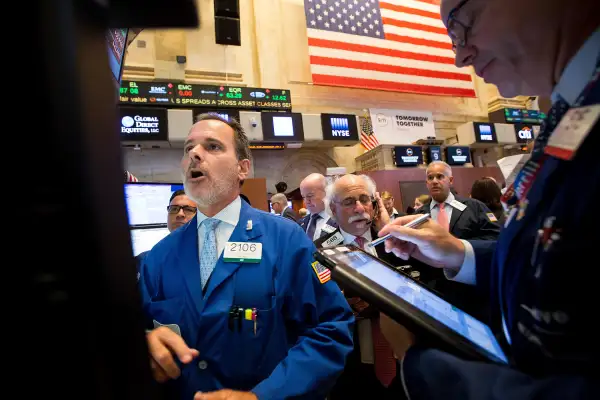Don't Freak Out Because The Federal Reserve Might Raise Interest Rates
Money is not a client of any investment adviser featured on this page. The information provided on this page is for educational purposes only and is not intended as investment advice. Money does not offer advisory services.

Your average investor might wish that Fed officials keep their thoughts to themselves.
Stocks were enjoying a comfortable rise ever since stumbling in the beginning of the year, and recovering from a temporary "Brexit" dip, until the whispers of a potential interest rate increase suddenly became dismaying.
The Dow Jones industrial average dropped nearly 400 points on Friday, the worst decline since Britain voted to leave the European Union in June, after the words and actions of Federal Reserve officials led market participants to believe that a September interest rate hike was suddenly possible.
Combined with the European Central Bank's decision to leave interest rates at current levels, rather than cutting further, has brought panic back in vogue. Equities started down on Monday, but rallied later in the morning, with the Dow finishing up almost 1.3% for the day as concern about a near-term hike abated somewhat. But the prospect of another Fed increase still looms, and has the power to rock the stock market anew.
The "era of eerie calm has come to an end, in part because of revised expectations of central bank policy — no more stimulus out of the the ECB or [Bank of Japan] and imminent tightening out of the Fed," notes Gluskin Sheff chief economist and strategist David Rosenberg. "So what do we have on our hands today? Answer in two words — more anxiety."
While security gyrations can cause you to imagine living out your golden years out on the streets in a gutter, you're better off remaining calm and sticking to your long-term investing plan. Here's why.
Fed Talk
If the Fed does raise interest rates after its meeting on Sept. 20 and 21, they'll have done a good job telegraphing the move. Nevertheless, it's also clear that not all Fed members are eager for a hike.
In a speech Monday, Atlanta Federal Reserve Bank President Dennis Lockhart said that the U.S. economy is strong enough to have a "serious discussion" over whether it is time to raise interest rates.
"I think circumstances call for a lively discussion next week," said Lockhart at the 58th National Association for Business Economics Annual Meeting in Atlanta.
Lockhart's comments dovetail with those made by Boston Fed President Eric Rosengren last week.
"My personal view, based on data that we have received to date, is that a reasonable case can be made for continuing to pursue a gradual normalization of monetary policy," said Rosengren in a speech to the South Shore Chamber of Commerce in Quincy, Mass.
At the same time, one of the central bank's advocates of low rates made a case for continued caution on an increase. In a speech Monday afternoon at the Chicago Council of Global Affairs, Federal Reserve Governor Lael Brainard, said, "This asymmetry in risk management in today's new normal counsels prudence in the removal of policy accommodation" — that is, keeping rates low.
Her speech, announced only last Thursday, helped rattle the markets last week, as some traders feared that Brainard's sudden appearance signaled an about-face. Monday is the final day before the Fed's so-called "blackout dates," when Fed officials limit their public comments before an upcoming meeting.
All these comments follow those made last month in a Jackson Hole, Wyo., by Fed Chair Janet Yellen, whose views carry the most weight.
“In light of the continued solid performance of the labor market and our outlook for economic activity and inflation, I believe the case for an increase in the federal funds rate has strengthened in recent months,” Yellen said.
Economic Data
So just how strong is the economy? Is there reason to believe that a interest rate hike is warranted?
The Fed has two mandates: to maximize employment and keep inflation steady. (The Fed has set a 2% rate of inflation as its benchmark.) Fed officials will also look at various other metrics, from economic growth to consumer spending to business activity, to gauge the economy's health.
So what do the numbers say? Well, it's not that clear.
Let's look at jobs. Employers added a humdrum 151,000 workers in August, below expectations. The jobs report was especially disappointing since the job market was believed to be picking up steam, with a 271,000 gain in June and a 275,000 pickup in July.
Wage growth seems to be stuck in a decent-but-not-great holding pattern as well. Hourly earnings increased by only 2.4% over the past 12 months in August, well below pre-recession levels. In fact, inflation as a whole hasn't quite had the lift-off Fed officials have been hoping for.
"I find the continuing shortfall from the Committee's inflation target and the ambiguous evidence of movement toward target to be a frustrating element in the picture," said Lockhart.
Economic growth has proved to be as frustrating. The gross domestic product grew at an annual rate of 1.2% in the second three months of 2016, after adjusting for seasonality and inflation, well below what economists's expectations. In Lockhart's speech, though, he said there is evidence that the growth rate could pick up to 3% in the third quarter, while full-year growth should land around 2%.
Recent Panics
Should you be concerned? Recent events should ease your mind.
Take the beginning of 2016. Fed officials were talking about raising interest rates four times this year. Then life happened. Markets reacted terribly to poor economic growth in China, weak oil prices, and a stronger dollar thanks to the Fed's December 2015 interest rate increase. Stocks endured the worst start to a year in history. In the four weeks ended Jan. 20, Money 50 fund Schwab S&P 500 dropped 7.1%.
Or the "Brexit." The Dow declined by nearly 900 points in the two days following Britain's voted to leave the EU.
So this year has been miserable for stocks, right? Not quite.
Before Fridays sell-off, the S&P 500 was up about 7% since the beginning of the year, and is now up 4.7%. While not outstanding, that's certainly a far cry from panic.
Whether or not the Federal Reserve acts in September or December or in 2017, rates will eventually increase.
"Without a significant improvement in [economic] fundamentals, investors would be well-advised to remember that there is an impending limit to how much liquidity injections can protect markets from the underlying economic reality," writes Mohamed El-Erian, chief economic adviser at Allianz, the German financial services giant, in Bloomberg.
And the stock market will jump around throughout. That's what stock markets do. But recent events, and historical data, should convince you that the only real move is to make no move at all.
